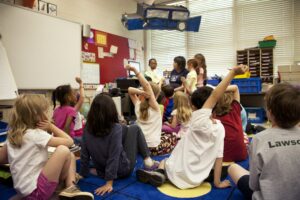This week I tackled the first module of the Open School Recourse course Blended Learning. Not going to lie, after reading through it this is sort of how I felt:
But only because there is a lot of great information presented on what blended learning is and how to effectively use it in a classroom. Since I am not a certified teacher yet, I am doing a lot of imagining “what could be…” in my classroom in terms blended learning. While imagining is exciting, it is also overwhelming because I have limited real life experiences to make connections to. Despite all of my feelings, I did find some interesting takeaways from the first module that are important to document.
Takeaway number one: Blended learning is an opportunity for teachers to evolve their teacher identity and their classroom to better suit a variety of student needs. Blended learning involves a combination of face to face instruction with web-based tasks and activities. Within this learning environment the teacher is able to adapt their role and become learning designers, mentors, or counsellors to their students. In other words, the teacher is no longer seen as the “knower of all things”, but rather a guiding adult to help with whatever the students need along their learning journey.
As the teacher evolves through blended learning, so does the classroom. In the module, a variety of blended learning models are described. My favourite model is called “Station Rotation”. This design is geared towards the elementary years and transforms the classroom from the typical teacher at the front, students in desks to a fluent exploration around the classroom. Three stations are set-up across the classroom: one for teacher led instruction, one for online learning, and one for collaborative activities. What I love about this model is that teachers are still needed for basic concept/content learning, but once that has been established students can move on to learning in more creative and collaborative ways.
Takeaway number two: Blended learning puts ownership on the student to be responsible for their own learning. Student-centered learning is a term that I have heard a lot about over the past month in all of my courses. And it is a concept that is highlighted through blended learning. The OSR course states that in blended learning “students have control over the time, pace, path, and place of their learning.” For elementary and middle school teachers, the idea of handing learning responsibility over to the students seems terrifying because how will they ever get anything done? The reality is most students want to succeed, but in traditional face to face instruction the responsibility to succeed is put on the teacher with little student control. However, in blended learning students are given freedom to learn when and how they want to. That freedom and responsibility is empowering for students and because they are at the focus of learning, not the teachers, they are more likely to succeed.



Leave a Reply
You must be logged in to post a comment.